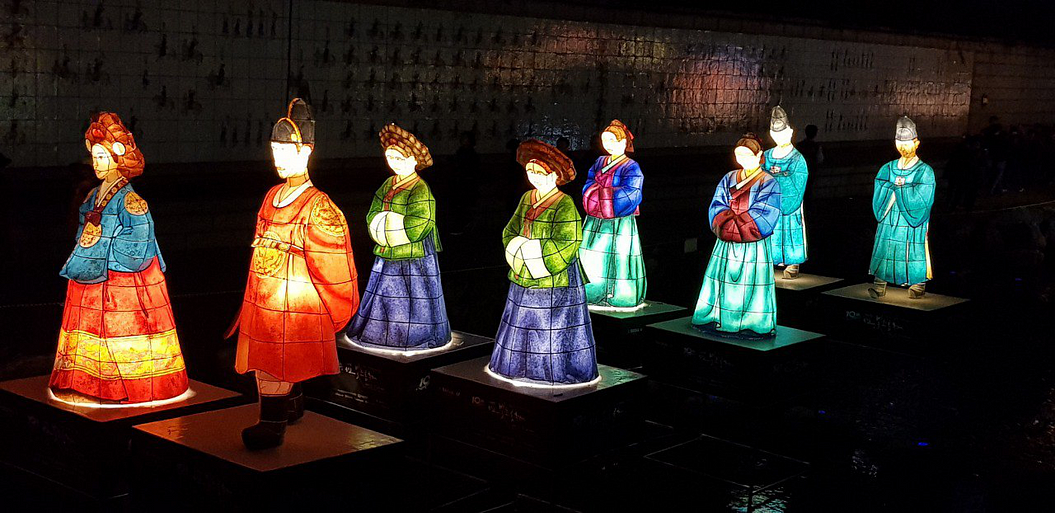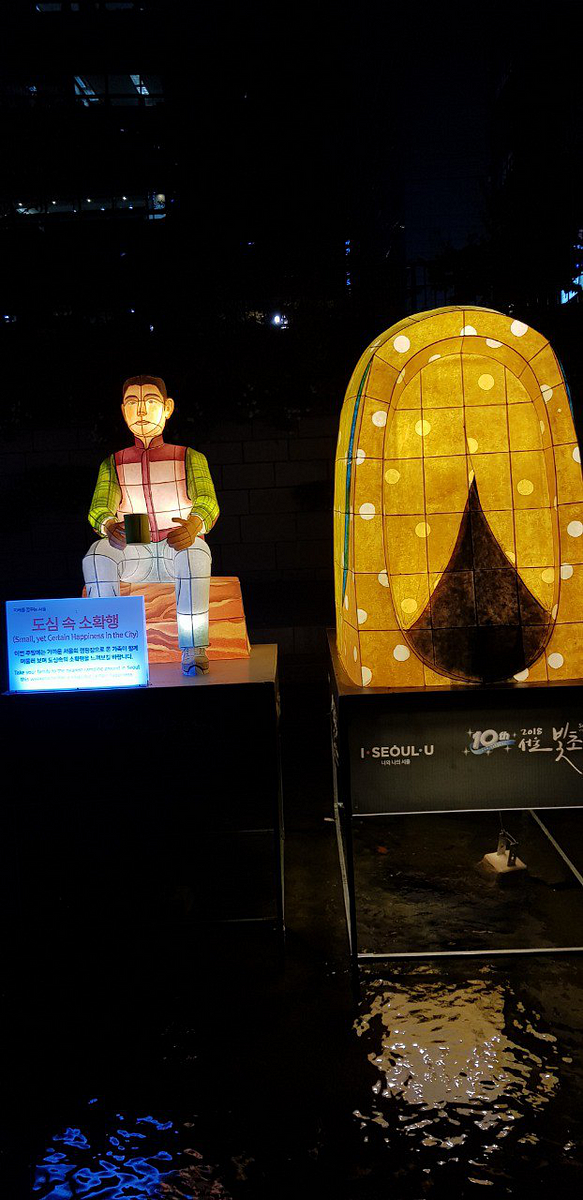Fall has gone and left us just sweet memories of different exciting festivals. Last time I told you about the Festival of Kimchi, today I will tell you about another nice festival.

Every year, but actually twice a year, there is a Lantern Festival in Korea. Usually one is in May, and another one is in November. Well, Spring and autumn are the best seasons to visit Korea. Both of the festivals are related to Buddhism. In May Korea celebrates a Buddha’s birthday. I don’t know what is a Buddhist holiday in November, but I will try to find it next time.

I am going to this festival every time and still can’t get enough of it. Why? Because it is really fantastic!

The main point of the festival is plenty of beautiful, creative, incredible lantern figures. And during the night all these figures are shining.
Furthermore, these lanterns are not just random figures, a line of some of them shows some stories, or maybe even Korean culture or history.


Like in the picture above, a group of people in Korean traditional dresses — hanbok. In ahead of the group king and queen, then their servants.


Each lantern, and each figure is very colourful and looks so realistic. And the size of each figure is pretty large. The height of the figures is more than 170cm.
 During the Buddha’s birthday, the lantern festival takes a place not only on Cheonggyecheon Stream but also in Buddhist temples too. I have been to Bongeunsa Temple during the Buddha’s birthday, and it looks like a magic land. A lot of lanterns around, and special ceremonies are organized. You can also visit the Jogyesa temple. It is also nice, but much smaller than Bongeunsa.
During the Buddha’s birthday, the lantern festival takes a place not only on Cheonggyecheon Stream but also in Buddhist temples too. I have been to Bongeunsa Temple during the Buddha’s birthday, and it looks like a magic land. A lot of lanterns around, and special ceremonies are organized. You can also visit the Jogyesa temple. It is also nice, but much smaller than Bongeunsa.
As long as it is a lantern festival, it is better to come here during the evening. Of course, during the day all lanterns are staying in the same place, but there is no light. And it looks totally different.
Besides traditional lanterns, there are some figures of different cartoon heroes as well. And I think they look even better than in the animation.


As at any festival, there is an experience corner as well in Lantern Festival. Last year, it was supported by UniPay. And everyone who had a UniPay card, or shared a photo of that booth in SNS, could make a small lantern by him/herself for free.

On the lantern sides, people wrote their wishes, then light a candle inside it, and put it on the river.

Every year, but actually twice a year, there is a Lantern Festival in Korea. Usually one is in May, and another one is in November. Well, Spring and autumn are the best seasons to visit Korea. Both of the festivals are related to Buddhism. In May Korea celebrates a Buddha’s birthday. I don’t know what is a Buddhist holiday in November, but I will try to find it next time.

I am going to this festival every time and still can’t get enough of it. Why? Because it is really fantastic!

The main point of the festival is plenty of beautiful, creative, incredible lantern figures. And during the night all these figures are shining.
Furthermore, these lanterns are not just random figures, a line of some of them shows some stories, or maybe even Korean culture or history.


Like in the picture above, a group of people in Korean traditional dresses — hanbok. In ahead of the group king and queen, then their servants.


Each lantern, and each figure is very colourful and looks so realistic. And the size of each figure is pretty large. The height of the figures is more than 170cm.

The lantern line is more than 10 km. The Festival is proceeding on cheonggyecheon Stream, and that gives some romantic and peaceful feeling. Especially, if you take a walk along the river during the evening. The festival starts from Kwanhwamun Square and goes to Dongdaemun District.

As long as it is a lantern festival, it is better to come here during the evening. Of course, during the day all lanterns are staying in the same place, but there is no light. And it looks totally different.
Besides traditional lanterns, there are some figures of different cartoon heroes as well. And I think they look even better than in the animation.


As at any festival, there is an experience corner as well in Lantern Festival. Last year, it was supported by UniPay. And everyone who had a UniPay card, or shared a photo of that booth in SNS, could make a small lantern by him/herself for free.

On the lantern sides, people wrote their wishes, then light a candle inside it, and put it on the river.

Every time I come here, I admire people’s talents and creativity. Look at these lanterns, each of them is very well-designed. Each detail is in its place. And it seems like these lanterns are like real people, and maybe they will start to move soon.
This lantern festival is like a small city, which is alive during the evening when other parts of the world are sleeping.
On the last day of the festival, there is a parade of lanterns along the main street of Seoul, in the Jongro district. Different lanterns “are walking” along the street with traditional music.
This lantern festival is like a small city, which is alive during the evening when other parts of the world are sleeping.
Comments
Post a Comment